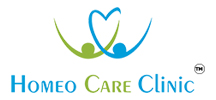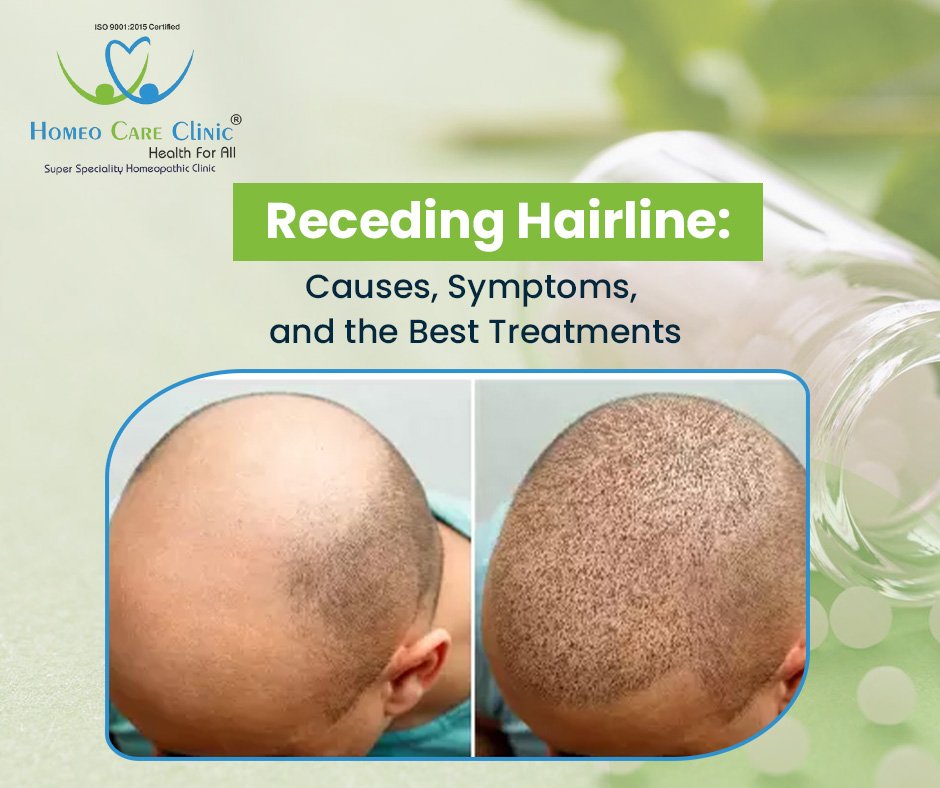Receding Hairline: Causes, Symptoms, and the Best Treatments
A receding hairline is one of the earliest and most common signs of hair loss. It refers to the thinning or loss of hair on the scalp, especially at the front and tip of the scalp, starting at the temple. While a maturing hairline is a normal part of ageing, excessive hairline loss may indicate male or female pattern baldness. A receding hairline may occur in both males and females, though it is more common in males. In fact, more than 50% of men experience a receding hairline by the time they are 50 years old. In this blog, let’s understand what a receding hairline is, the causes of a receding hairline, the treatment and how to stop a receding hairline.
What is a Receding Hairline?
A receding hairline occurs when the hair around the forehead starts thinning and moving back, creating an ‘M’ or ‘V’ shape. For men, it often starts at the temples, leading to a male receding hairline, while in women, it usually results in scalp hair thinning rather than complete baldness. A maturing hairline is a gradual change in hairline position due to ageing, whereas hairline loss can be excessive and lead to noticeable bald patches. Recognizing the difference between the two is key to finding the right hair receding treatment. How the hairline looks may depend on your sex at birth. A receding hairline is typically a sign of male pattern baldness, which usually progresses in distinct steps:
- A receding hairline may start from the temples and appear uneven at first, later developing into a distinct M shape.
- The hair on the top or back of the head begins to fall out, leaving a bald spot.
- These two signs then spread and meet, creating a larger bald spot.
- Eventually, a horseshoe-like ring is usually left around the sides and the back of the head.
How to tell if you have a Receding Hairline?
Symptoms of a receding hairline include:
- Hair becomes finer and less dense around the temples.
- One side of the forehead may recede more than the other.
- The forehead appears larger as hair thins.
- More hair than usual falls out when brushing or washing.
- The hairline does not grow back at the same rate as the rest of the scalp.
- Hair on the crown and sides may also appear thinner.
- Complete frontal baldness that moves toward the back of your scalp
- Complete hair loss or thin hair above temples that forms an “M” or “V” shape
- Zigzag pattern or balding patches along the hairline
A receding hairline can range from mild to severe, in which no hair is left on the top of your head.
Receding Hairline Causes
Our scalp has hundreds of thousands of hairs that grow from follicles beneath the skin’s surface. These hairs generally fall out and are replaced by new ones. In fact, we tend to lose dozens of hairs every day. But if hair follicles are damaged or a medical condition can disrupt the growth cycle, it can result in a receding hairline. Here are the causes of a receding hairline:
- Genetics and Hormonal Changes
If you are noticing a receding hairline, genetics may be the biggest factor that affects both males and females. If you have a genetic predisposition to hair loss, your hair follicles will eventually shrink and stop growing hair. Hormonal changes may trigger a receding hairline in males. An androgen hormone called DHT may impact the hair growth cycle, resulting in male-pattern baldness. Women may also experience hairline thinning, especially during pregnancy or menopause, due to hormonal shifts.
- Ageing and Natural Hairline Maturity
A maturing hairline is a normal part of ageing, but if hairline loss happens too early or progresses quickly, it could be a sign of pattern baldness. Hair loss is a part of the natural aging process and will affect most people at some point. As we age, our hair growth slows, leading to scalp hair thinning, particularly at the temples and forehead. It is estimated that more than 50% of males over the age of 50 have some type of hair loss. By age 70, nearly 80% of males and 50% of females are affected.
- Stress and Lifestyle Factors
Chronic stress can push hair follicles into a resting phase, which may lead to hairline thinning. Poor nutrition, particularly low iron or protein intake, can also slow hairline regrowth. Hairstyles that pull hair too tightly or excessive heat styling can weaken strands, worsening hair loss at the hairline over time.
- Medical Conditions and Medications
Certain medical conditions, such as alopecia areata, can lead to patchy hairline loss. Thyroid imbalances, iron deficiency, scalp infections and medications like chemotherapy drugs or hormone treatments can also contribute to a thinning hairline.
How to Stop a Receding Hairline
Want to stop receding hairline naturally? While it may be difficult to stop hair loss due to genetics. However, if your hair loss is caused due to stress, medications, hair care or a lack of nutrients, you may be able to prevent it. Do the following to slow down your receding hairline:
- Avoid tight hairstyles: Tight hairstyles like ponytails, buns, or braids can cause tension and traction on the hair follicles, potentially leading to hair breakage and damage. Go for a loose and comfortable hairstyle and avoid hair accessories that pull on the hair.
- Regularly oil your hair: Apply oil to your hair to nourish and cleanse the toxins in the hair. After oiling, brush your hair properly to ensure the oil reaches the roots and also improves blood circulation.
- Hydrate Well: Hydration is critical for overall health, including hair health. Drink plenty of water throughout the day to stay hydrated, as it helps your body, including your hair follicles, function properly.
- Balanced Diet: Include a variety of nutrient-rich foods in your diet, such as fruits and vegetables, lean proteins, and healthy fats. Hair health requires nutrients such as vitamins A, C, D, and E, biotin, and iron. Consult a healthcare professional or a nutritionist for personalized dietary advice.
- Stress management: Stressful circumstances may cause excessive sweating. Practice stress-reduction strategies like meditation, exercise, deep breathing, or engaging in hobbies to help lower stress levels, which can help the health of your hair inadvertently.
Receding Hairline Treatment
For long-term results, medical therapies are more effective than home remedies in order to effectively treat receding hairlines. The treatment preferences can differ based on the individual, but these treatment options are available:
- Medications: If you opt for medications to treat your receding hairline, you can buy over-the-counter solutions or ask your doctor about prescribed medications. Your doctor can discuss medicines like Minoxidil, which is sold at drugstores, along with other options like oral finasteride. Your doctor may also recommend using prescription medications alongside ketoconazole 2% shampoo.
- Hair transplant: Hair transplant surgery involves extracting hair follicles from the back or sides of the scalp and implanting them onto the bald or thinning areas. This helps to restore hair growth naturally and offers effective results for people suffering from baldness, receding hairlines, or hair thinning.
- Platelet-rich plasma (PRP Therapy): PRP Hair treatment is a simple 3-step procedure to reduce the frequency of hair loss in different conditions. In the PRP process, we draw the person’s blood, process it, and then inject it into the scalp to stimulate the natural growth of the hair.
- Low-Level Laser Therapy: Low-Level Laser Light (LLLT), is a non-invasive treatment that promotes hair growth and reduces hair loss. It works by using a low-intensity red laser light on the scalp, which stimulates hair follicles and improves blood circulation. The increased circulations help to nourish the follicles, leading to thicker and healthier hair over time. It is a painless procedure with no downtime, which makes it a popular choice for people experiencing thinning hair or the early stages of baldness.
Hairstyles for Receding Hairline
Changing your hairstyle may help you draw attention away from your receding hairline and even help you look confident while dealing with hair loss. A stylish example of a hairstyle for a receding hairline is the slicked-back undercut, where the person grows the hair on top of their head out and cuts the sides shorter. Once long enough, they can slick back the hair on top of their head using a brush or a product. Other popular hairstyles for receding hairlines include a close buzz cut, a medium crew cut, a textured crop or a clean shave.
Conclusion
Dealing with a receding hairline can be challenging because it affects your appearance and may affect other aspects of your health. With the right hair treatments, you can restore your hair growth and improve hair health. PRP Hair Restoration is suitable for both men and women. It is a state-of-the-art, nonsurgical, totally natural, alternative medical procedure used for the treatment of hair loss or hair thinning. At Homeocare Clinic, we are dedicated to providing our patients with the best quality and personalised treatment plans tailored to fulfil their specific requirements. Our experienced team of dermatologists offers safe, natural, and highly effective solutions to promote the regrowth of our patients’ hair. Contact us now for the best hair treatment in Pune.


